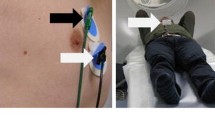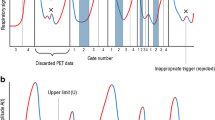Abstract
Purpose
Respiratory motion of organs during PET scans is known to degrade PET image quality, potentially resulting in blurred images, attenuation artefacts and erroneous tracer quantification. List mode-based gating has been shown to reduce these pitfalls in cardiac PET. This study evaluates these intrinsic gating methods for tumour PET scans.
Methods
A total of 34 patients with liver or lung tumours (14 liver tumours and 27 lung tumours in all) underwent a 15-min single-bed list mode PET scan of the tumour region. Of these, 15 patients (8 liver and 11 lung tumours in total) were monitored by a video camera registering a marker on the patient’s abdomen, thus capturing the respiratory motion for PET gating (video method). Further gating information was deduced by dividing the list mode stream into 200-ms frames, determining the number of coincidences (sensitivity method) and computing the axial centre of mass of the measured count rates in the same frames (centre of mass method). Additionally, these list mode-based methods were evaluated using only coincidences originating from the tumour region by segmenting the tumour in sinogram space (segmented sensitivity/centre of mass method). Measured displacement of the tumours between end-expiration and end-inspiration and the increase in apparent uptake in the gated images served as a measure for the exactness of gating. To estimate the accuracy, a thorax phantom study with moved activity sources simulating small tumours was also performed.
Results
All methods resolved the respiratory motion with varying success. The best results were seen in the segmented centre of mass method, on average leading to larger displacements and uptake values than the other methods. The simple centre of mass method performed worse in terms of displacements due to activities moving into the field of view during the respiratory cycle. Both sensitivity- and video-based methods lead to similar results.
Conclusion
List mode-driven PET gating, especially the segmented centre of mass method, is feasible and accurate in PET scans of liver and lung tumours.









Similar content being viewed by others
References
Beyer T, Townsend DW, Brun T, Kinahan PE, Charron M, Roddy R, et al. A combined PET/CT scanner for clinical oncology. J Nucl Med 2000;41:1369–79.
Kinahan PE, Townsend DW, Beyer T, Sashin D. Attenuation correction for a combined 3D PET/CT scanner. Med Phys 1998;25:2046–53.
Lang N, Dawood M, Büther F, Schober O, Schäfers M, Schäfers K. Organ movement reduction in PET/CT using dual-gated list-mode acquisition. Z Med Phys 2006;16:93–100.
Klein GJ, Reutter BW, Ho MW, Reed JH, Huesman RH. Real-time system for respiratory-cardiac gating in positron tomography. IEEE Trans Nucl Sci 1998;45:2139–43.
Nehmeh SA, Erdi YE, Ling CC, Rosenzweig KE, Squire OD, Braban LE, et al. Effects of respiratory gating on reducing lung motion artifacts in PET imaging of lung cancer. Med Phys 2002;29:366–71.
Dawood M, Büther F, Lang N, Schober O, Schäfers KP. Respiratory gating in positron emission tomography: a quantitative comparison of different gating schemes. Med Phys 2007;34:3067–76.
Koch N, Liu HH, Starkschall G, Jacobson M, Forster K, Liao Z, et al. Evaluation of internal lung motion for respiratory-gated radiotherapy using MRI: part I—correlating internal lung motion with skin fiducial motion. Int J Radiat Oncol Biol Phys 2004;60:1459–72.
Büther F, Dawood M, Stegger L, Wübbeling F, Schäfers M, Schober O, et al. List mode-driven cardiac and respiratory gating in PET. J Nucl Med 2009;50:674–8.
Rietzel E, Chen GTY, Choi NC, Willet CG. Four-dimensional image-based treatment planning: target volume segmentation and dose calculation in the presence of respiratory motion. Int J Radiat Oncol Biol Phys 2005;61:1535–50.
Ernst I, Büther F, Dawood M, et al. Bewegliche Targets und ESRT - Bewegungsdetektion mittels PET/CT. Proceedings ESRT Dresden 2008; ISBN 978-3-00-026254-8.
He J, O’Keefe GJ, Jones G, Saunder T, Gong SJ, Geso M, et al. Evaluation of geometrical sensitivity for respiratory motion gating by GATE and NCAT simulation. Conf Proc IEEE Eng Med Biol Soc 2007;1:4165–8.
Daube-Witherspoon ME, Muehllehner G. Treatment of axial data in three-dimensional PET. J Nucl Med 1987;28:1717–24.
Wink NM, Panknin C, Solberg TD. Phase versus amplitude sorting of 4D-CT data. J Appl Clin Med Phys 2006;7:77–85.
Nehmeh SA, Erdi YE, Ling CC, Rosenzweig KE, Schoder H, Larson SM, et al. Effect of respiratory gating on quantifying PET images of lung cancer. J Nucl Med 2002;43:876–81.
Lupi A, Zaraccolo M, Salgarello M, Malfatti V, Zanco P. The effect of 18F-FDG-PET/CT respiratory gating on detected metabolic activity in lung lesions. Ann Nucl Med 2009;23:191–6.
Bundschuh RA, Martínez-Moeller A, Essler M, Martínez MJ, Nekolla SG, Ziegler SI, et al. Postacquisition detection of tumour motion in the lung and upper abdomen using list-mode PET data: a feasibility study. J Nucl Med 2007;48:758–63.
Schleyer PJ, O’Doherty MJ, Barrington SF, Marsden PK. Retrospective data-driven respiratory gating for PET/CT. Phys Med Biol 2009;54:1935–50.
Belderbos J, Heemsbergen W, Hoogeman M, Pengel K, Rossi M, Lebesque JV. Acute esophageal toxicity in non-small cell lung cancer patients after high dose conformal radiotherapy. Radiother Oncol 2005;75:157–64.
Balter JM, Ten Haken RK, Lawrence TS, Lam KL, Robertson JM. Uncertainties in CT-based radiation therapy treatment planning associated with patient breathing. Int J Radiat Oncol Biol Phys 1996;36:167–74.
Allen AM, Siracuse KM, Hayman JA, Balter JM. Evaluation of the influence of breathing on the movement and modeling of lung tumors. Int J Radiat Oncol Biol Phys 2004;58:1251–7.
Keall P. 4-dimensional computed tomography imaging and treatment planning. Semin Radiat Oncol 2004;14:81–90.
Guckenberger M, Wilbert J, Meyer J, Baier K, Richter A, Flentje M. Is a single respiratory correlated 4D-CT study sufficient for evaluation of breathing motion? Int J Radiat Oncol Biol Phys 2007;67:1352–9.
Acknowledgements
The authors thank Ulrike Althof, Rabea Berkenkopf, Anika Brunegraf, Björn Czekalla, Bertold Könemann, Anette Langnickel, Yvonne Mehlich, and Katarzyna Quirós-Hoppe for excellent technical assistance, and Bernard Bendriem, James Hamill, Judson Jones and Hartwig Newiger of Siemens Molecular Imaging (Knoxville, TN, USA and Erlangen, Germany) for valuable discussions. This study was supported by the Deutsche Forschungsgemeinschaft (DFG), Sonderforschungsbereich 656 - Molecular Cardiovascular Imaging (SFB 656 Projects B2, B3, C2 and C6) and a research grant to the European Institute for Molecular Imaging (EIMI) from Siemens Medical Solutions (Erlangen, Germany).
Conflicts of interest
None.
Author information
Authors and Affiliations
Corresponding author
Rights and permissions
About this article
Cite this article
Büther, F., Ernst, I., Dawood, M. et al. Detection of respiratory tumour motion using intrinsic list mode-driven gating in positron emission tomography. Eur J Nucl Med Mol Imaging 37, 2315–2327 (2010). https://doi.org/10.1007/s00259-010-1533-y
Received:
Accepted:
Published:
Issue Date:
DOI: https://doi.org/10.1007/s00259-010-1533-y




